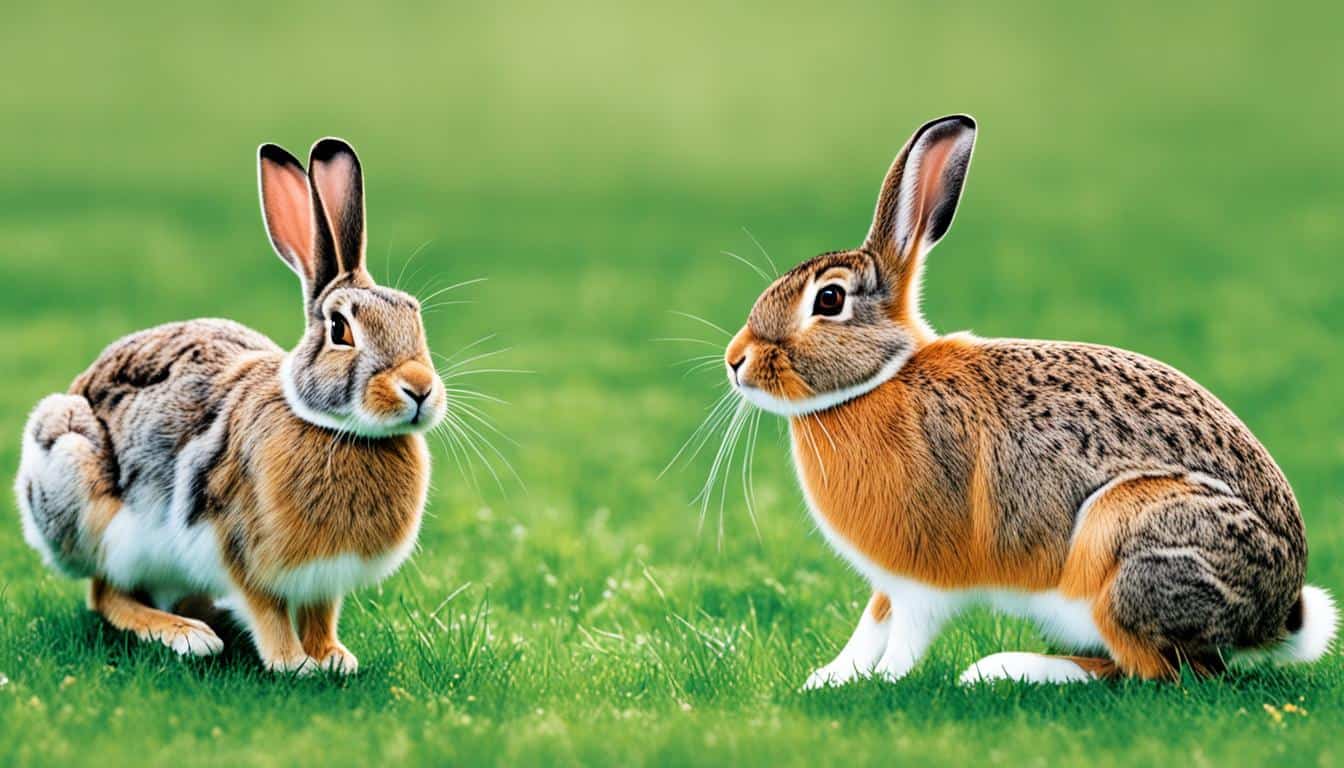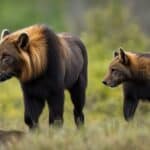The terms “hare” and “rabbit” are often swapped, yet they mean different things. This hare vs rabbit differences understanding begins with their names. “Hare” comes from older English, but “rabbit” was adopted from French in the 14th century.
Both animals are in the lagomorph order and eat plants. While hares are bigger with longer ears and legs, rabbits are more social. They live in groups in underground homes. On the other hand, hares prefer solitary above-ground nests, known as forms.
Hares and rabbits also have a notable birth difference. Hares are born fully furred and with their eyes open. In contrast, rabbits are born without fur and can’t see at first. This distinction helps in telling hare and rabbit apart.
Introduction to Lagomorphs: Hares and Rabbits
The lagomorph order includes hares and rabbits. They’re different from rodents because they have two rows of upper incisors. This unique feature helps us see the special behaviors and traits of these animals.
Understanding the Lagomorph Order
Hares and rabbits are in the same lagomorph order but have differences. Hares, for example, are born with fur and open eyes, while rabbits start off blind and without hair. They both have a key feature in common, though: two rows of upper incisors.
Common Misconceptions
It’s easy to mix up “jackrabbit” and “swamp hare.” But “jackrabbit” really means a type of hare, not a rabbit. This rabbit or hare comparison can mislead people. Learning the right words helps you understand the different species in the hare and rabbit lagomorphs group better.
Physical Differences Between Hares and Rabbits
It’s important to know the differences between hares and rabbits. They both come from the same family but look different. The main differences are in their size, fur, eye color, and their ears and legs.
Size and Weight
Size and weight are key in telling hares and rabbits apart. Hares are bigger, can be 70cm long, and weigh 2-5kg. In comparison, rabbits get up to 40cm and weigh 1.2-2kg. This makes it easier to know if it’s a hare or a rabbit just by looking at them.
Fur and Eye Color
Looking at their fur and eye color also helps with identification. Hares have a mix of russet brown and black-tipped ears. But rabbits have a more consistent, greyish-brown fur and no black ear tips. They also have different eye colors, with hares having amber eyes and rabbits having dark brown eyes.
Ear and Leg Length
The length of their ears and legs is another clear difference. Hares have very long ears, sometimes with tips that are black. In comparison, rabbits have shorter ears. Hares also have longer, stronger back legs. This makes them faster runners than rabbits.
| Feature | Hares | Rabbits |
|---|---|---|
| Size | Up to 70cm | Up to 40cm |
| Weight | 2-5kg | 1.2-2kg |
| Fur Color | Grizzled russet brown, black-tipped ears | Greyish-brown |
| Eye Color | Amber | Dark brown |
| Ear Length | Long, black-tipped | Shorter |
| Legs | Long, powerful hind legs | Shorter hind legs |
Habitat Preferences
It’s key to know the *hare vs rabbit habitat* differences to see how these animals live and grow in their areas. Hares live in open spaces like prairies. They also like arable farmland and the edges of woodlands. They sleep in forms, which are shallow places in the ground. This helps them stay hidden from danger but ready to escape quickly. Their choice of living space shows they like to be by themselves. Also, they need a quick hiding place since they don’t live together in groups.
Rabbits, on the other hand, prefer places with lots of trees and bushes. They like to be able to dig and make underground homes called warrens. *Rabbit and hare ecosystems* are very different. Rabbits’ warrens protect them from predators. The warrens are also a place where they can live and find food together, close to their shelter.
| Hare Habitat | Rabbit Habitat | |
|---|---|---|
| Preferred Areas | Open fields, prairies, arable farmland | Forested areas, shrublands |
| Shelter Type | Above ground in forms | Underground warrens |
| Social Structure | Solitary | Communal |
| Cover Availability | Requires quick cover due to limited shelter | Protected by burrows |
By looking at the *hare vs rabbit habitat* differences, we see how smart they are about survival. Hares use their speed and alertness in wide, open spaces. Meanwhile, rabbits depend on their hidden, shared homes for safety and being together. Each species has its own way to live well in their environment.
Behavioral Traits of Hares vs Rabbits
When we look at the hare and rabbit behavior comparison, we see clear differences. Hares like being alone or with just one other. They’re very fast, running up to 45 mph to escape threats. Hares don’t dig burrows. Instead, they make beds in shallow holes in the ground.
On the other hand, rabbits behave in a completely opposite way. They enjoy the company of others and live in groups. When danger comes, they hide in their burrows together. Living in a group helps them warn each other about threats. This choice impacts how they survive and interact with their environment.
The table below shows the key hare vs rabbit characteristics:
| Behavioral Trait | Hares | Rabbits |
|---|---|---|
| Social Structure | Solitary or in pairs | Group living |
| Speed | Up to 45 mph | Slower, retreats to warrens |
| Nesting Habits | Open depressions (forms) | Underground warrens |
| Predator Evasion | Running high speed | Hiding in burrows |
Recognizing these behavior differences is crucial. Knowing how hares and rabbits react to danger and where they make their homes is important. This information helps us understand what makes them unique.
Reproduction and Offspring
Learning about how hares and rabbits reproduce and grow up tells us a lot. It shows how they survive and fit into their habitats.
Gestation Periods
Hares and rabbits have very different times before giving birth. This shows their unique ways of making babies. *Hare and rabbit reproduction* means rabbits have babies quicker, in about 30-31 days. But, for hares, it takes a bit longer, around 42 days.
Birth and Development
The way rabbit and hare babies are when they are born is also different. Rabbit babies are born without sight and hair, needing their parents a lot. In contrast, hare babies come into the world already able to see, with fur and independence. This gap in the *gestation periods of lagomorphs* affects how well each animal can live in their surroundings.
Hares: The Runners of the Open Fields
When trying to tell a hare and a rabbit apart, where they live and how they adapt is key. Hares are great at running, a perfect fit for the fields. Their long legs help them run fast, which is crucial for dodging danger.
Hares don’t dig burrows like rabbits. Instead, they choose shallow spots called forms for hiding. This is one way to know if it’s a hare or a rabbit.
Hares’ legs are tailor-made for running. This skill is vital when you live in the wide open. It lets them watch out for predators and get away quickly.

Because of their love for the open fields and their special way of hiding, hares are really interesting. They’re quite unique when it comes to figuring out identifying a hare vs rabbit.
Rabbits: Social Animals of the Underground
Rabbits have a unique way of living. They create intricate homes underground. These underground rabbit warrens keep them safe from danger and bad weather. The tunnels are well-organized, with areas for sleeping, raising babies, and even a spot for waste.
When we look at how rabbits and hares live, it’s clear they choose different places. Hares like wide open spaces and build lone above-ground nests. In contrast, rabbits build their lives together under the ground. This choice for communal living helps them stay safe and build strong friendships, which is very different from the way hares live.
“The underground rabbit warrens are a marvel of social engineering, ensuring the well-being and survival of their populations through carefully constructed chambers and tunnels.” – National Geographic
Their ability to create such intricate homes shows how smart rabbits are. They know how to work together to build safe places. This skill helps experts tell rabbits apart from hares, not just by looks but by lifestyle too.
| Feature | Hare | Rabbit |
|---|---|---|
| Social Structure | Solitary | Communal |
| Habitat | Above-ground nests (forms) | Underground rabbit warrens |
| Young | Born with fur, open eyes | Born hairless, blind |
Key Identification Tips
Finding out if it’s a hare or a rabbit is simple if you know what to look for. They differ in size, ear shape, and fur color. Their behaviors also help in telling them apart in the wild.
Spotting Physical Characteristics
Hares are notably bigger and have longer ears than rabbits. Look for the black tips on their ears and their amber eyes. Conversely, rabbits are smaller with shorter, grey-brown fur. They have a white tail and shorter ears without the black tips.
Observing Behavior
Paying attention to how they act can also hint at whether it’s a hare or a rabbit. Hares like being alone and often found in open fields. They run really fast to avoid danger. On the other hand, rabbits enjoy the company of their friends near their burrows.
Rabbits are social beings, living near trees or bushes. Living in groups, they are always alert and warn each other when there’s danger.
| Characteristic | Hare | Rabbit |
|---|---|---|
| Size | Larger | Smaller |
| Ear Length | Long with black tips | Shorter |
| Eye Color | Amber | Dark Brown |
| Coat | Grizzled russet brown | Grey-brown with white tail |
| Behavior | Solitary | Gregarious |
Historical and Cultural Significance
Hares and rabbits are key in different global cultures. They are linked to fertility and new beginnings. This is because they have many offspring and represent life’s renewal.
Myths and Folklore
In ancient Egypt, hares connected to Osiris symbolized new life after death. European tales often show the hare as a clever trickster. They showcase its intelligence and speed.
In Native American folklore, the rabbit is seen as wise and aiding others. These myths highlight a deep respect for nature and its balance.
Modern Day Representation
The Easter Bunny remains a beloved tradition, originating from the Easter Hare in Germany. It represents spring, fertility, and gifting children with eggs.
Even outside Easter, rabbits and hares have made their mark. They appear in books, cartoons, and as mascots. Their universal appeal shows their enduring importance in culture.
Common Species of Hares and Rabbits
It’s key to know the main types of hares and rabbits out there. Look at the Brown hare and the Mountain hare. The Brown hare has long back legs and a tail that’s black at the tip. It’s often seen in fields and farms in Europe. The Mountain hare has a white coat in winter. It lives in cold, mountain areas. And its fur changes to blend in better with the snow.
Then we have the European rabbit. It’s found in lots of places and has a coat that’s grey-brown. It likes living in fields, woods, and cities. What’s interesting is how these rabbits make big homes underground and often go looking for food in groups.
These hares and rabbits have spread to new places all around. They help the land and are important to many other animals as food. Knowing about their part in nature helps us respect and protect them.
FAQ
How do you distinguish between a hare and a rabbit?
Hares and rabbits are easy to tell apart. Hares are bigger and have longer ears and legs. They usually have a grizzled russet-brown coat. You’ll see them usually by themselves, above ground. On the other hand, rabbits are smaller, with shorter ears and greyish-brown fur. They live in groups under the ground.
What is the difference between the lagomorph order and rodents?
The lagomorph order, which includes hares and rabbits, is known for two rows of upper incisors and a plant-based diet. This is different from rodents, which have a single set of incisors and eat different things.
How can I identify a hare based on its physical characteristics?
Hares are bigger and have longer hind legs. Their ears have black tips. They usually have a grizzled russet brown coat and amber eyes.
Where do hares and rabbits prefer to live?
Hares like open areas such as prairies and fields, where they make nests in shallow places. Rabbits, on the other hand, prefer places with shrubs and trees. They live in burrows underground.
How do the behaviors of hares and rabbits differ?
Hares usually live alone and are very fast, running up to 45 mph. They sleep above ground. In comparison, rabbits live in groups and hide in their burrows when scared.
What are the differences in reproduction between hares and rabbits?
Hares have a longer pregnancy, around 42 days, and their young are born ready to go with fur and eyes open. Rabbits, however, have a quicker gestation period, about 30 days, and their babies are born blind and without fur.
Why are hares referred to as good runners?
Hares need to be fast in the open fields, so they have long, strong back legs for sprinting. They’re not into burrowing. Instead, they look for shelter in forms on the ground.
How do rabbits exhibit social behavior?
Rabbits live in organized groups below ground, where they have different rooms for different activities. They show a lot of social structure with these setups.
What are the key features to look for when identifying a hare or a rabbit?
To spot the difference, check their size, ear length, and the color of their coat and eyes. Hares have big, black-tipped ears and amber eyes, while rabbits’ ears are shorter and they have grey-brown coats and dark eyes. Observing their behavior and where they live can also help you decide.
What is the historical and cultural significance of hares and rabbits?
In many cultures, both hares and rabbits symbolize fertility and are linked with springtime. Stories and traditions, like the Easter Bunny, show their cultural importance, coming from the German Easter Hare tradition.
What are some common species of hares and rabbits?
Popular hare species include the Brown hare (Lepus europaeus) and the Mountain hare (Lepus timidus). Rabbits are often the European rabbit type (Oryctolagus cuniculus). They’re all important parts of their ecosystems.







